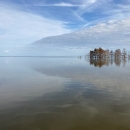About Us
Swanquarter National Wildlife Refuge is an extensive coastal marsh which includes the Swanquarter National Wilderness Area. The refuge hosts large concentrations of diving ducks (lesser scaups, redheads, buffleheads, canvasbacks, and surf scoters), sea ducks, American black ducks, wading birds and shorebirds, especially during the winter. Wading bird rookeries, osprey nesting and colonial nesting birds occur. Refuge habitats consist of irregularly flooded brackish marsh (13,200 acres) and forested wetlands (3,200 acres). The refuge provides habitat for American alligators and bald eagles as well as protection for migratory waterfowl and other birds. The refuge is administered by Mattamuskeet NWR.
Our Mission
Vision
Swanquarter NWR functions as a vital part of the Refuge System and is an important wintering area for migratory birds, such as ducks, geese, and swans, on the Atlantic flyway. The refuge maintains breeding habitat for a variety of migratory birds. The refuge protects and enhances a healthy brackish marsh ecosystem and an upland forest ecosystem, and maintains the natural and primitive character of the large wilderness area wilderness area
Wilderness areas are places untamed by humans. The Wilderness Act of 1964 allows Congress to designate wilderness areas for protection to ensure that America's pristine wild lands will not disappear. Wilderness areas can be part of national wildlife refuges, national parks, national forests or public lands managed by the Bureau of Land Management.
Learn more about wilderness area . It provides habitat for threatened and endangered animals, particularly the red-cockaded woodpecker, red wolf, and American alligator.
Visitors enjoy quality recreation opportunities such as fishing by boat or from the Bell Island pier, crabbing, waterfowl and deer hunting, and wildlife observation and photography. Visitors understand and appreciate the significance of the north Pamlico Sound ecosystems and the importance of refuge management activities.
The refuge staff works with partners and volunteers to achieve the refuge’s goals. Essential scientific information is garnered through research conducted at Swanquarter NWR in cooperation with government agencies, non-governmental agencies, universities, and others.
Refuge Purpose
Each unit of the National Wildlife Refuge System is established to serve a statutory purpose that targets the conservation of native species dependent on its lands and waters. All activities on those acres are reviewed for compatibility with this statutory purpose.
The purpose of Swanquarter National Wildlife Refuge, as reflected in the refuge’s authorizing legislation, is to protect and conserve migratory birds, and other wildlife resources through the protection of wetlands, in accordance with the following laws:
“... for use as an inviolate sanctuary, or for any other management purpose, for migratory birds.” 16 U.S.C. ¤ 715d (Migratory Bird Conservation Act of 1929)
Other Facilities in this Complex
The refuge is managed as part of the Coastal North Carolina National Wildlife Refuge Complex. A National Wildlife Refuge Complex is an administrative grouping of two or more refuges, wildlife management areas or other refuge conservation areas that are primarily managed from a central office location. Refuges are grouped into a complex structure structure
Something temporarily or permanently constructed, built, or placed; and constructed of natural or manufactured parts including, but not limited to, a building, shed, cabin, porch, bridge, walkway, stair steps, sign, landing, platform, dock, rack, fence, telecommunication device, antennae, fish cleaning table, satellite dish/mount, or well head.
Learn more about structure because they occur in a similar ecological region, such as a watershed or specific habitat type, and have a related purpose and management needs.
There are 9 national wildlife refuges in the Coastal North Carolina National Wildlife Refuges Complex. The Project Leader for the Complex supervises the Refuge Managers who are responsible for managing these refuges. However, there are five distinct and separate administrative offices. Alligator River and Pea Island National Wildlife Refuges are administered from the Alligator River National Wildlife Refuge Headquarters in Manteo, NC. An administrative office at the Mackay Island National Wildlife Refuge Headquarters in Knotts Island, NC manages both Mackay Island and Currituck National Wildlife Refuges. An office at Mattamuskeet National Wildlife Refuge administers Mattamuskeet, Swanquarter, and Cedar Island National Wildlife Refuges. Pocosin Lakes National Wildlife Refuge, Roanoke River National Wildlife Refuge, Great Dismal Swamp National Wildlife Refuge, Back Bay National Wildlife Refuge, and Edenton National Fish Hatchery each have separate administrative offices.
All of the Coastal North Carolina National Wildlife Refuges, Great Dismal Swamp National Wildlife Refuge, Back Bay National Wildlife Refuge, and Edenton National Fish Hatchery are open to public visits for nature-based recreational enjoyment. Priority public uses are hunting, fishing, wildlife observation, wildlife photography, environmental education, and interpretation.




